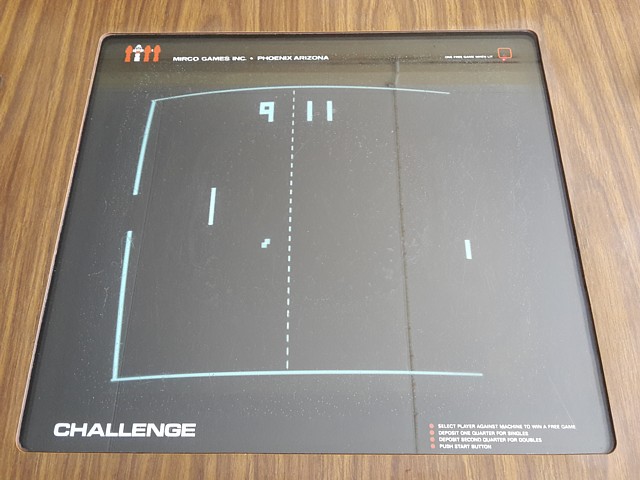
Early arcade machines didn't save High Scores, these were lost every time the machine was turned off which was usually daily. In lieu of that, here's a few photos of scores I've recorded on my own machines.
I never played arcade games much back in the day and even now spend more time fixing the games than playing the working ones. I'm not a 'gamer' as such and don't have the spare time or concentration to pursue a really high score.
Having said that I've gone from a collection of projects where nothing worked to having a number of machines which are playable, at least and thought I'd take a phone photo of any decent scores and update those here. Perhaps keeping a record of the previous high score will add incentive to raise the bar, who knows...

Challenge, Mirco
Principally a 2 or 4 player Vs player Pong game, the Mirco Challenge also has a player Vs machine mode where 1 or 2 players can play against a wall with a 'goal' area. The only way to score is to deflect the ball through the opening at an angle, not quite as easy as it sounds.
This really is a test of concentration and drifting off while playing is a definite issue, in my experience at least. The score on the left is the number of times you miss the ball and lose a point, the number on the right is the number of successful goals. The main skill here is to never miss the ball.
As in most Pong style games the ball starts out slow and speeds up, twice in this machine so it seems to become more difficult to get the angle right if you don't do it early on before the ball speeds up too much. If I'm not mistaken only the horizontal speed of the ball increases, not the vertical with the effect that the deflection angles are reduced as the ball speeds up.
First to 11 (or 15 I think, depending on a switch setting) wins, usually the machine however I have beaten it at least once as you can see here. If you reach 11 before the machine a red LED in the top right corner lights and you are treated to a free game, possibly the first ever video machine to feature that as well as the ability for 2 player co-operative play.
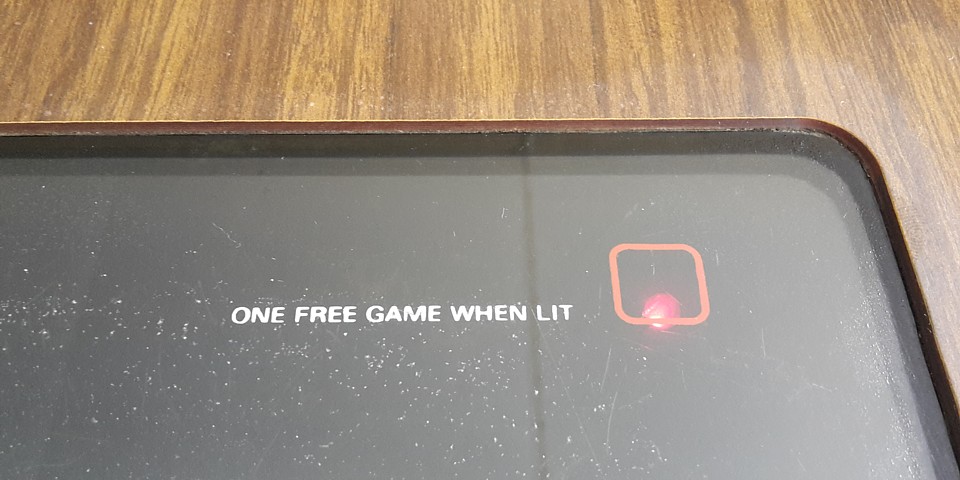
According to the manual, the free game is not repeated if you win a second time but I've not been able to verify that as yet, I have since won a 2 Players Vs machine game and confirmed in that instance the free game was also a 2 player game.
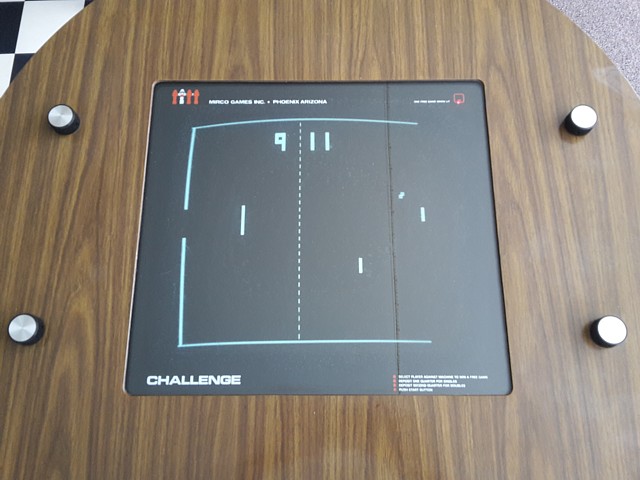
Although the maximum score for this machine is only 11 (or 15 as previously mentioned) there is still the possibility to improve by reaching that with a lower score on the machines side. The difficulty would increase exponentially with a decrease of the machines score, to reach 11 goals for no balls missed would be near impossible!
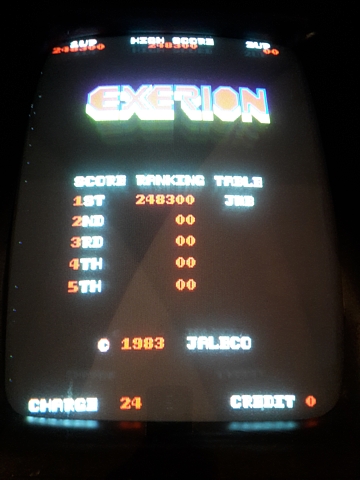
Exerion, Jaleco
I love this game! I originally stumbled across it as a search result on KLOV, looking for vertical games which could be played with 2 buttons. I've since managed to find two non-working boards, repaired them both and installed one into my upright machine which previously had a 60 in 1 board fitted, keeping the second as a working spare.
Anyone who enjoys Galaga should like this, it has features found in many other vertical space shooters and the added dimensions of 8-way movement and a semi 3D parallax scrolling background. The background layer actually has no effect on gameplay other than to distract the player but does make the game more interesting and colourful to view.
The player's ship has a feel of 'inertia' to it, responding gradually to the joystick and there are two fire buttons, an unlimited double cannon and a limited rapid fire machine gun on button 2. I was hopeless at the game initially, relying entirely on the machine gun and concentrating on keeping the stream of projectiles on target instead of not being hit.
Eventually I learned to use the double cannon which adds 'charge' to the machine gun with every 'hit' and save that weapon for enemies which require multiple hits to destroy (the Big Birds!). There's a great variety of enemy targets reminiscent of other games and some bonus levels, Galaga style which add to charge rather than score in this case.
It's interesting to fly up over and around the enemies, leading them in a sort of spiral before swooping below and trying to pick them off. I'll never be in the running for a record score on this or any game as I lose concentration after a while, the more I like the game the further I'm likely to get of course and this is a favourite at the moment.
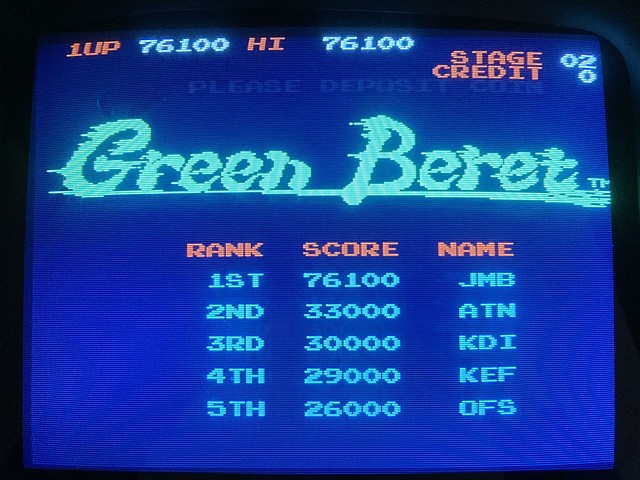
Green Beret, Konami
This isn't one of my all time favourites but I'm warming to it despite its slightly off putting theme. Known as Rush'n Attack in the U.S. the aim is to 'rescue the captives' by single handedly hacking, blasting and flaming your way through a heavily guarded enemy base. In reality this classic 2D scrolling game is less graphic than most combat games since.
It was installed in an upright machine which I bought working with only a few minor issues to sort out so I've no reason to change it and am gradually increasing my score as I play it. The most mportant skill here seems to be timing, too soon and your attack will miss, too late and well, too late.
At least there are some 'checkpoints' built into each level so if you lose a life well into a level you don't have to start again from the beginning. There's four main stages and I haven't had enough skill and enthusiasm yet to even complete the second, maybe with more practise Ill get further and more 'involved' with the game, we'll see.
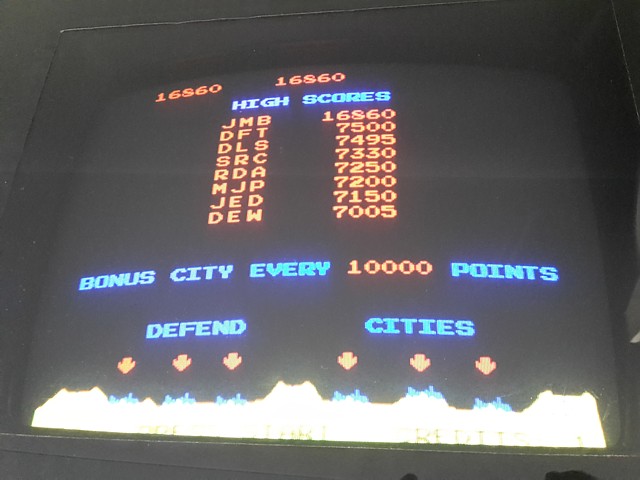
Missile Command, Taito (Atari)
OK, so I know I'm being a bad player who blames the equipment but here goes. Missile Command is a deliberately difficult game at the best of times but I can't help feeling this genuine, licensed machine makes it impossible to survive more than a few attack waves.
It's a Taito cocktail machine, apparently made under licence for Japan and Australia. Atari had their own cocktail version for the US and Sega made a licensed version for the UK. The issue, I believe with this version (and possibly all of the cocktail machines) is their 2 1/4" trackballs.
Although the same size as the Atari Mini Trak Ball, I suspect their 'gearing' which is mainly determined by the number of slots on the optical encoder assembly - is too low, making the operation of the smaller trackballs painfully slow compared to the 4 1/2" Trak Ball used in the original upright machine.
Even when the DIP switch setting for the track ball rate is correctly set for the mini sized control it seems impossible to move it fast enough, requiring many sweeps of the ball to move the pointer across the screen.
The game itself is brilliant, instilling a sense of panic in the player with the most basic of graphics, a real masterpiece for 1980. I had no real intention of modifying this machine to make it easier but there did seem to be a number of ways the performance of the mini trackballs could be improved,,,
The most obvious solution would be to increase the resolution of the optical encoders, making some new discs with more / finer slots - easy to achieve with a 3D printer - also substituting a new optical sensor assembly with a narrower aperture to suit the smaller slots in the disc.
Another option occurred to me, having read a recent web article and detailed disassembly of the Missile Command program (link below) I realised the trackball speed could be increased with the change of a single byte of code. In fact the change is just one bit in that byte and has no effect on the gameplay or difficulty other than to give the trackball a faster rate of movement.
Such a simple change I couldn't resist trying, programming one EPROM with the single bit 'hack' and I'm really happy with the improved 'feel' of the trackball. The game still seems really difficult but not quite so frustrating whereas before I cursed the inability of the trackball to move the crosshairs fast enough now it is my own reflexes which are tested.
We'll see if I can improve upon my previous best with the aid of the faster controls but I'll still never achieve a really high score, my skill and concentration not being up to the challenge. At least 'THE END' comes quickly!
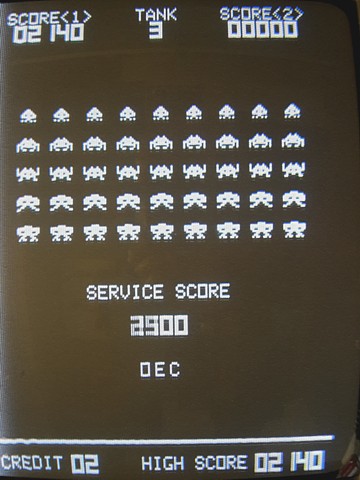 |
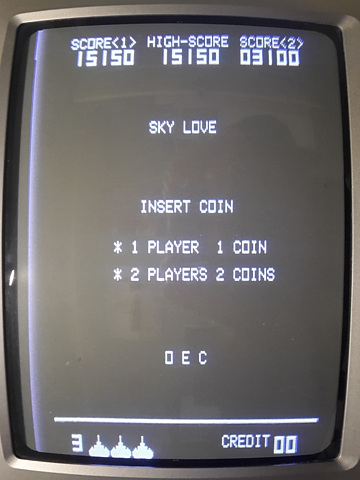 |
Shuttle Invader / Sky Love, Omori Electric Co.
This isn't a complete machine as yet, just a PCB on the test bench and it's a Shuttle Invader PCB which I've slightly modified to allow it to also run the 'Sky Love' game, both by Omori Electric Co. and made around 1979. This is not emulation - Shuttle Invader and Sky Love both employed similar hardware.
Sky Love is an interesting variation on the 'Space Invader' style vertical shooter. Tha laser base is there, still with simple left, right, fire controls but the airborne enemy are a mixture of rocket ships and UFOs moving around independantly.
There are also frequent missiles descending from above which cannot be destroyed and must be avoided. Unlike Space Invaders there are no barriers to hide behind so the approach seems to be to keep moving, sweeping back and forth to avoid the barrage from above and taking pot shots when any craft strays into the path of your laser.
I'm hoping to find or build a suitable cocktail style cabinet to house this PCB and may improve upon these scores with 'proper' controls and screen positioning but the scores above are a good starting point.

Space Invaders, Logitec (Taito)
The gameplay of this Logitec Space Invaders Cocktail machine is identical to my Taito Space Invaders Colour although achieved using slightly different hardware, the only noticeable difference apart from the name on the attract screen (and the six digit score display) is one of the sounds. On this machine the laser base firing sound continues until the shot hits something or leaves the screen while the equivalent sound on the Taito is just a momentary burst.
This variation is a little off putting as the sound is heard almost continuously during gameplay but you learn to ignore it after a while or turn its volume down a little if it's too distracting. The main reason why my scores are lower here than on my Taito version is this machine's 2 way joystick could use some adjustment.
In this case the microswitches on the Player 1 Left / Right control are set a little too fine and if you are not very careful the laser base moves unexpectedly into the path of enemy fire! A simple adjustment should correct that but it is a reminder of the days when playing an unknown machine in a new location there were often factors beyond ones control which affected your scoring ability.
In a way the slight variations between one machine and another are what give them character, an attribute which is missing when played under emulation on a PC keyboard with LCD screen...

Space Invaders, Taito
So this is a genuine Taito Space Invaders Colour PCB set, in this case fitted to a Taito red upright cabinet. Gameplay is the same as the earlier Black and White versions but the score displays are 5 digits instead of 4, allowing for scores higher than 9,990.
It doesn't matter though as I've never come close, this is the best I've managed so far. It should be noted that I have not attempted the now well known strategy of creating a safe gap where you cannot be hit then picking the Invaders off along the very bottom row when you are immune to their shots.
No, I'd rather persist with the old fashioned approach, blasting away at one side of their ranks or the other to slow their descent, avoiding their fire all the while. I realise I'll never get too far with this method but at least it's a 'fair fight' and I'll keep trying for the magic 10,000 mark.
Web Resources (External Links) -
Missile Command (1980) Disassembly
All images and text on this website are Copyright.
Contact: jbtech at telstra dot com